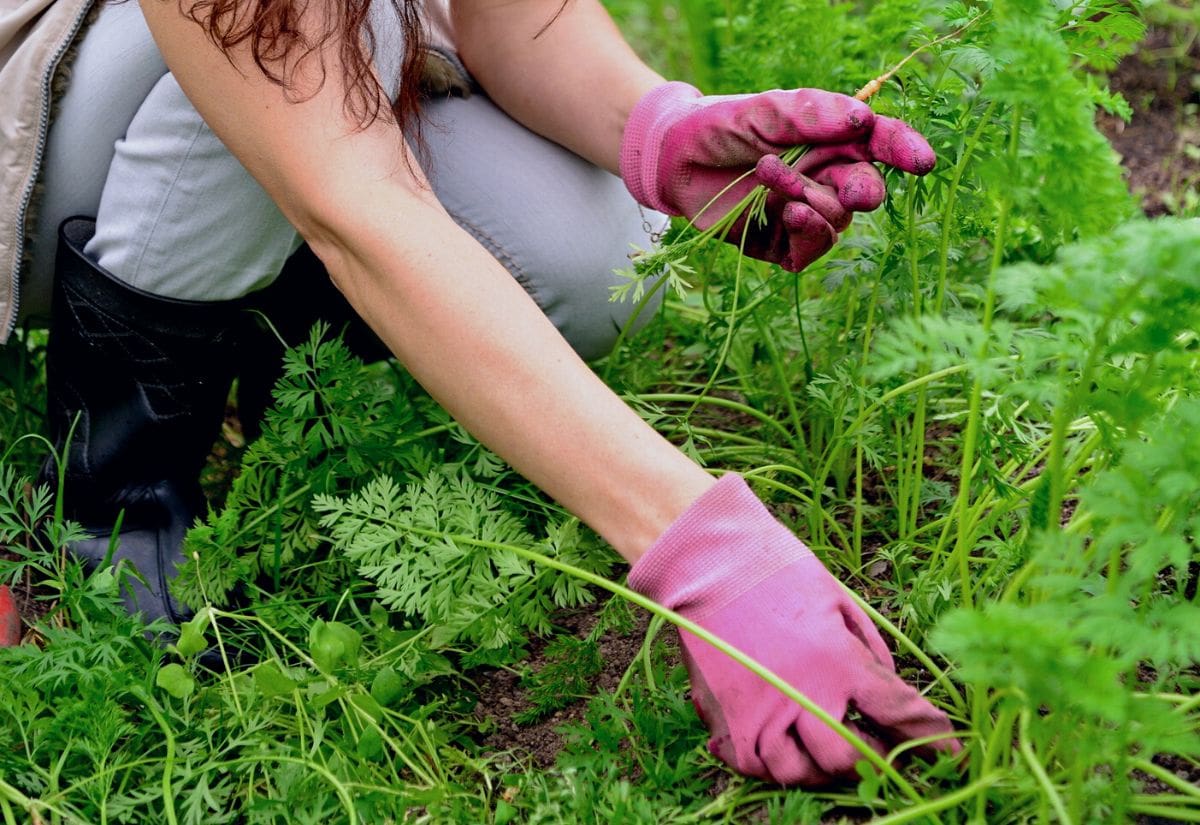
There are a lot of important points to consider when growing carrots: careful sowing, persnickety weeding, patience for slow germination, and then of course thinning.
But with everything else you have to worry about in the garden, is thinning carrots really that necessary?
Can’t I just throw my carrot seeds in the ground and let them grow? Yes, you can, but you will often have a better crop of carrots if you thin them.
Thinning is when you pull out some seedlings so the others have more space and nutrients to grow. The result will be bigger, straighter, and tastier carrots.
For best results, thin your carrots when the tops are 2cm to 3cm (1 inch) tall. Snip off any seedlings so that the remaining carrots are about 5cm to 10cm (2-4 inches) apart depending on the variety you are growing.
Keep reading for an in-depth discussion on when and how to properly thin carrots in two stages for perfectly shaped and deliciously sweet carrots.
7 Reasons Why Carrots Should Be Thinned
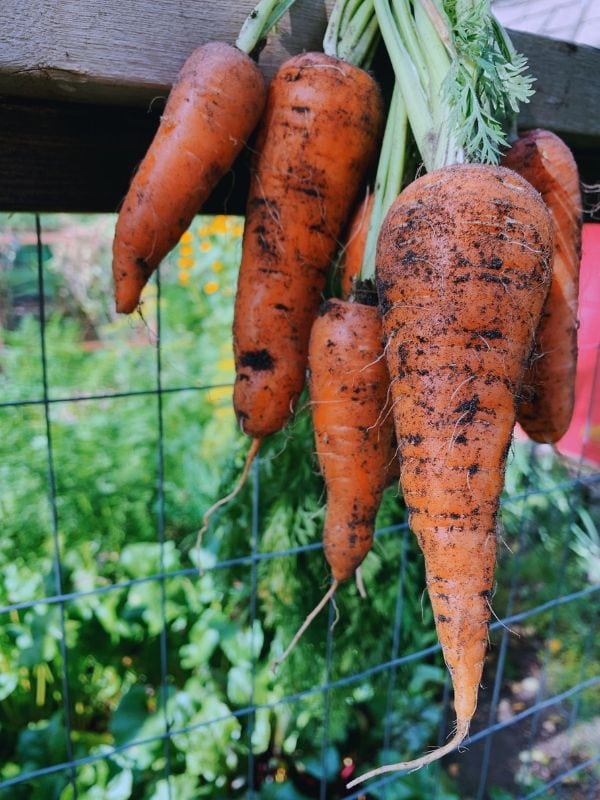
After you have waited patiently for your carrot seeds to finally germinate, it will seem like a shame to pull any of the fastidious roots. But there are a number of benefits to thinning out your carrots, such as:
Do You Need To Thin Out Carrots?
In short, no you do not have to thin carrots. We have grown many carrot crops without ever thinning and have been rewarded with a great harvest.
However, when carrot seeds are initially planted, multiple seedlings can sprout from the same seed cluster, resulting in crowded and cramped conditions that can stunt growth and produce misshapen carrots.
By thinning weak or stunted-looking carrot seedlings and pulling out excess plants, you can give the remaining carrots enough space to develop properly, resulting in healthier, tastier, and more abundant harvests.
Good Sowing For Successful Thinning
How you thin your carrots will depend greatly on how you sow them. Every gardener has their preferred way to sow carrots, but it is important to sow carrots in a way that your thinning can be done once with great success.
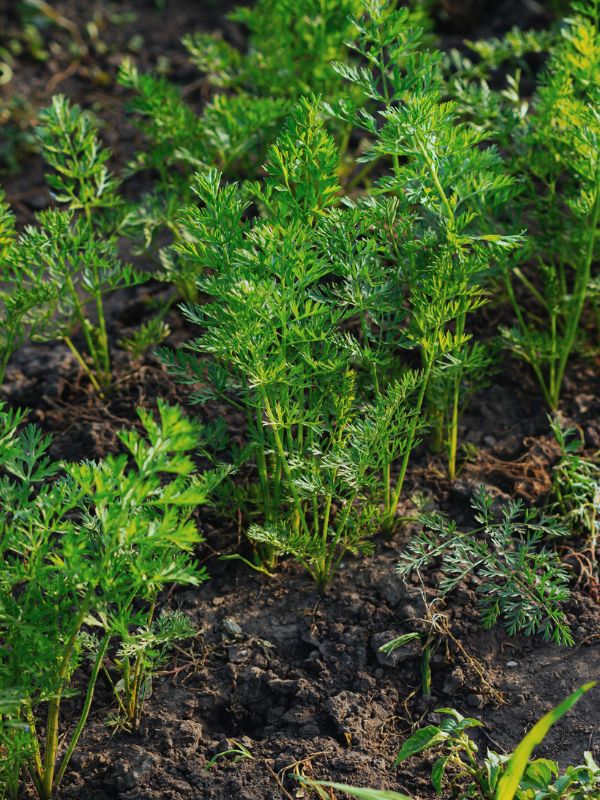
Attempt to sow carrot seeds 2cm to 3cm (1 inch) apart so you will only have to thin out a few carrots to attain the desired spacing. If you have difficulty handling the small seeds and find yourself sprinkling them too closely,
mix your seeds with a small amount of sand. Then when you sprinkle the seed/sand mix, it will help disperse the carrots more sparsely in the row.
If your hands are steady you can sow your carrots 5cm to 8cm (2-3 inches) apart and you won’t have to thin at all, but be prepared for a spotty carrot patch if your germination rate is low.
Carrots can be sown more closely than this, and some seed companies suggest planting 4 carrots every 2.5cm (1inch) to compensate for low germination. However, this means you have to thin a lot more carrots to achieve good spacing so is a rather uneconomical practice.
Thin Carrots Once…And Only Once
Many growers recommend thinning carrots two, or even three, times in a single growing season. The first thinning leaves the carrots 1” apart, then a few weeks later they are thinned again to around 2”, followed by a final thinning that leaves 3-4” between the carrots.
The advantages of this are that it allows you to pick the best carrots, and your resulting carrot patch will have very uniform and consistent growth.
While this can produce a truly excellent carrot crop, it is a wasted economy in my mind. I would prefer to thin my carrots all at once, so I have more time for other required tasks later in the season.
If you are growing carrots to sell, thinning them multiple times might be a worthwhile practice to have exceptionally uniform carrots, but the extra labor must be offset by the price at the market stall.
What To Do With Thinned Carrots
Despite the advantages for your crop, thinning carrots might seem like a waste of perfectly growing food. However, the carrots that you thin do not have to go to waste. You can:
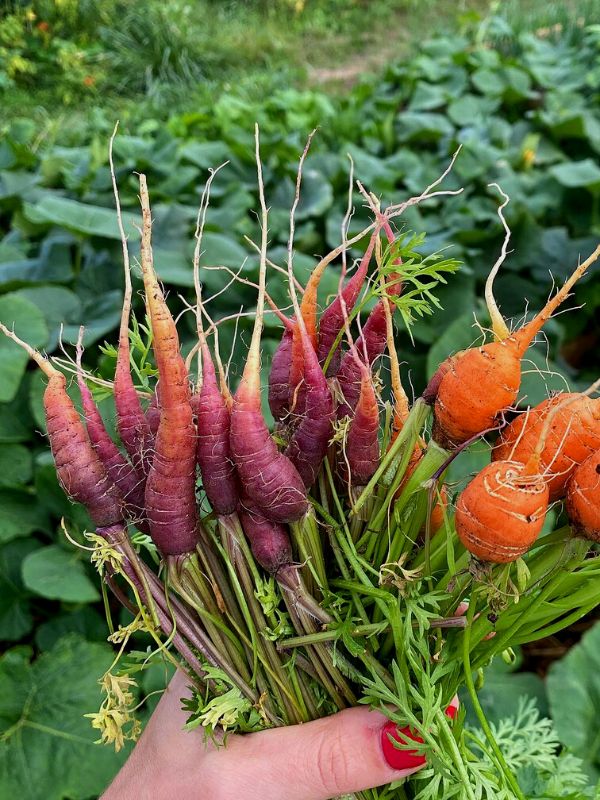
Can You Replant Thinned Carrots?
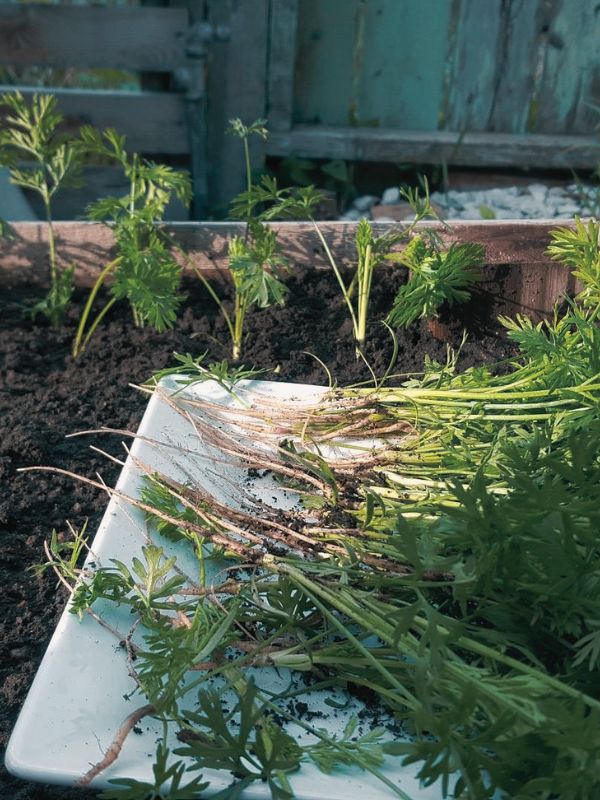
It might be tempting to transplant your thinned carrots. However, like all root crops, carrots are extremely finicky to transplant.
Most often, the tops will droop and wither before they take root in their new environment. While transplanting them might be an interesting experiment, it is probably not worth the time and effort required to nurture them.
When Is The Best Time To Thin Carrots?
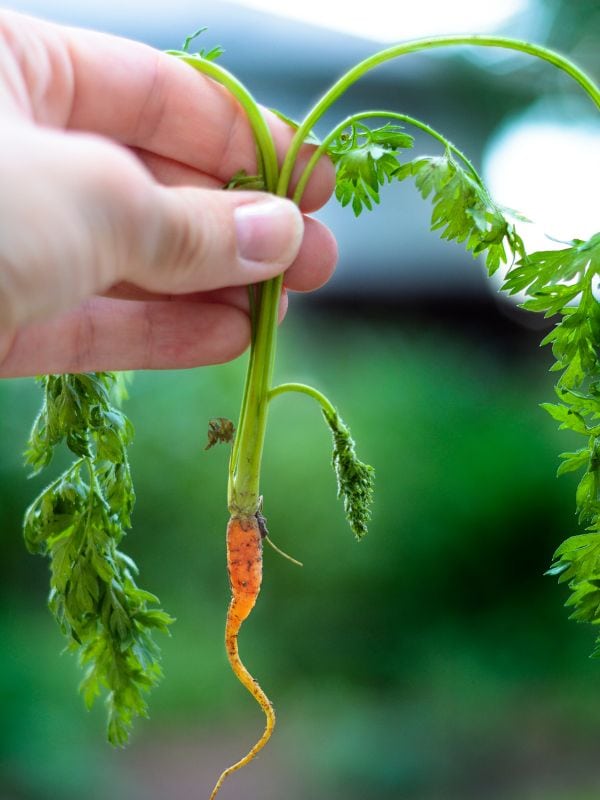
Carrots should be thinned in early summer when they are small seedlings. Thin carrots when they are about 2.5 cm(1 inch) tall, which is usually when they have 3 or so true leaves. When you are done, you want the remaining carrots to be 5cm to 10cm (2-4 inches) apart depending on the variety.
If you are growing thinner varieties, such as Nantes or Imperator, the carrots can be closer while wide carrots like Danvers or Chantenay should be on the wider end of this range.
With this spacing, carrots do not need thinning again, but you can thin them whenever you want fresh carrots. All carrots can be eaten as baby carrots, so don’t need to wait to harvest them all. Instead ‘thin’ them by pulling out what you want to eat and letting others grow bigger in freed space.
Thin In The Rain
Old garden wisdom suggests thinning carrots on a wet day, preferably when it is lightly raining. This is supposed to reduce the risk of attracting carrot flies as the moisture helps dampen the smell. Also, it is easier to pull the carrots when the soil is slightly damp.
How To Thin Carrot Seedling for Optimal Root Development
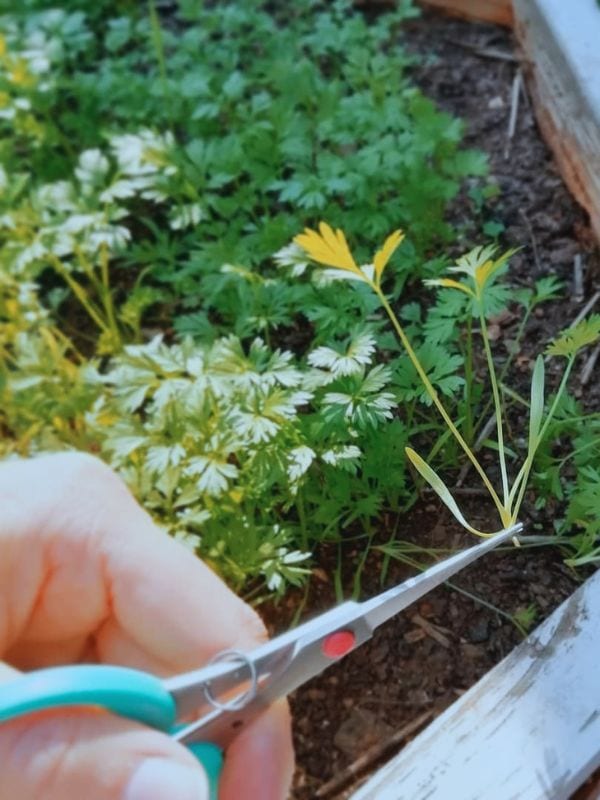
The safest way to thin carrots is to snip them. To thinning carrot seedling, take a pair of scissors or garden shears and snip off any carrots that you want to remove. Young carrot seedlings are very fragile, and this causes the least disturbance to the surrounding veggies.
To pull the seedlings instead of snipping, press one finger firmly into the ground directly beside the carrot top, and pull the carrot out at a slight angle to avoid damaging the neighboring carrots.
Thinning Mature Carrots to Create Perfectly Spaced Rows
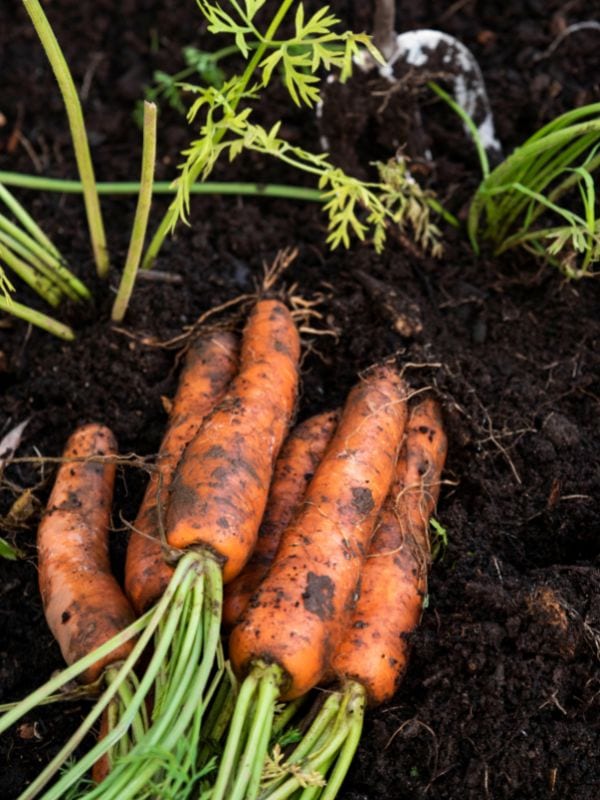
If you have to thin mature carrots, loosen the soil lightly with a shovel (without digging up the entire row), and gently pull the carrot.
Try not to damage the tops, as carrot flies have been known to smell a damaged carrot leaf up to six miles away.
Thinning Carrots In Containers
It is far easier to space carrots in containers than it is in the garden, so if you can space your seeds at sowing, thinning might not be necessary.
That being said, thinning container-grown carrots can be just as important as thinning carrots in the garden, and perhaps even more so since moisture and nutrients in pots are even more limited and you don’t want your carrots crowded and competing with each other.
Thin carrots in containers just like the carrots in your garden.
Preventing Carrot Fly Infestation
Carrot flies can always find their way to your carrot patch, but they are particularly attracted every time the leaves are touched or damaged, or when the soil around the roots is disturbed, which is exactly what happens when you thin carrots.
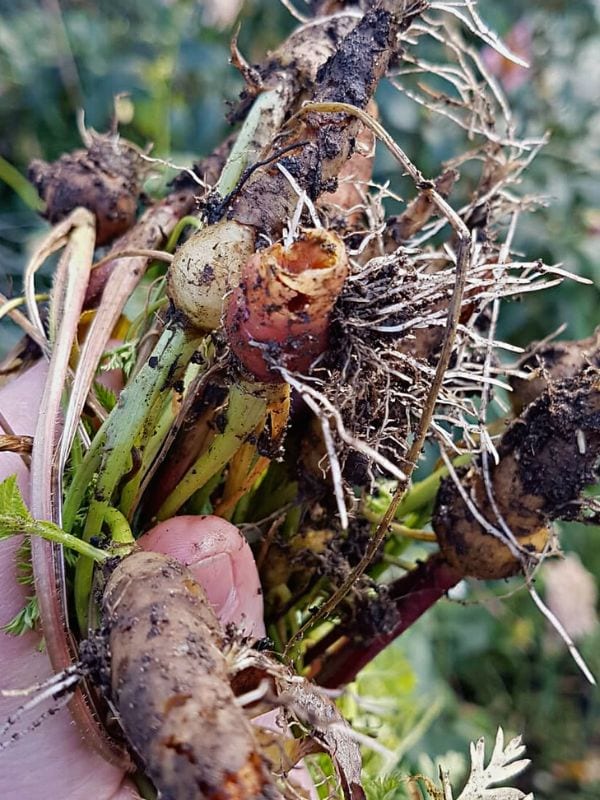
Here are some tips to keep the devastating carrot fly away from your newly thinned crop:
The Lazy Gardener’s Way To Thin Carrots
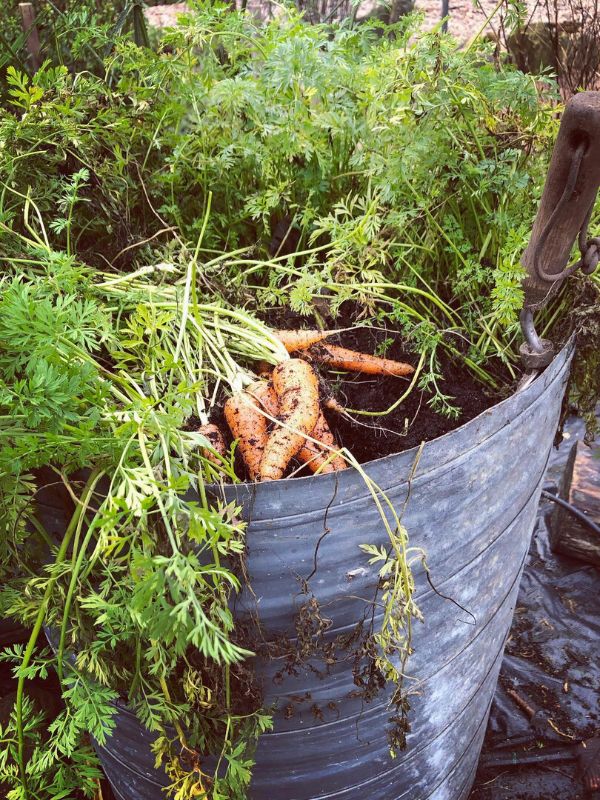
If you are like me, thinning your carrots might be high on your priority list in the early spring, but this task quickly falls by the wayside as the season heats up.
If you find yourself not getting around to thinning carrot seedlings, don’t worry. You can thin your carrots each time you need some for a meal. Simply pick out what you need and let the others continue growing.
Of course, the disadvantage of this is that you might thin too late so your carrots might not grow as big or as straight as if you had thinned earlier.
Also, you are more likely to disturb the carrots you are leaving in the ground, potentially inhibiting their growth or attracting insects like the carrot fly.
Conclusion
Some years we have a hard time getting carrots to successfully germinate, so we don’t want to pull any of the precious roots. Other times, we simply get too busy and we don’t get around to thinning.
No matter how your garden is growing, I hope this article has encouraged you to give thinning your carrots a try, and you can see for yourself what a difference this simple chore can make come harvest time.

Written By
Amber Noyes
Amber Noyes was born and raised in a suburban California town, San Mateo. She holds a master’s degree in horticulture from the University of California as well as a BS in Biology from the University of San Francisco. With experience working on an organic farm, water conservation research, farmers’ markets, and plant nursery, she understands what makes plants thrive and how we can better understand the connection between microclimate and plant health. When she’s not on the land, Amber loves informing people of new ideas/things related to gardening, especially organic gardening, houseplants, and growing plants in a small space.

Wow! I liked it
This a nice piece